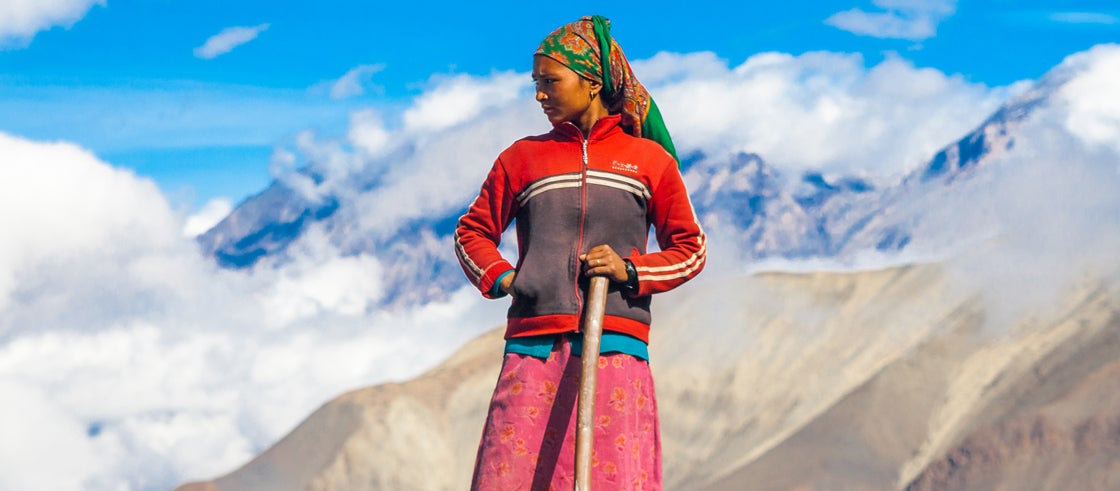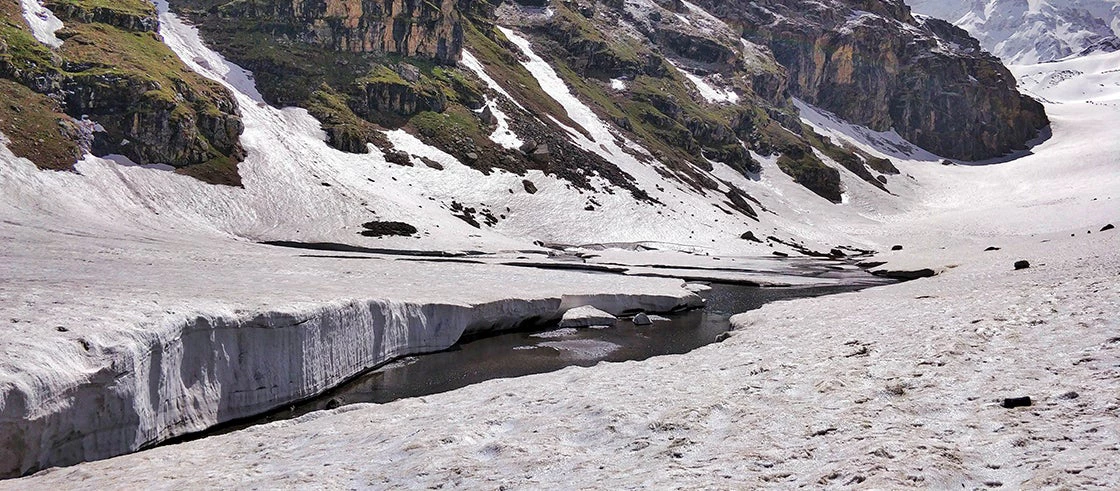 Local women is standing in the mountains holding a shovel.
Local women is standing in the mountains holding a shovel.
Kumik village sits in the picturesque Zanskar valley high in the Himalayas. Travelers had long considered this valley an oasis amid the barren mountain ranges.
Once home to one of the oldest and most remote civilizations on the planet, agriculture and livestock flourished in this area thanks to plentiful water flowing from the surrounding glaciers.
However, over the years, the glaciers receded, making the village unlivable. Finally, as meltwater dwindled to a trickle and irrigation canals went dry, residents had no option but to move.
Today, the empty Kumik village stands as a cautionary tale against the dangers of melting glaciers. This phenomenon is likely to lead to water scarcity for millions of people in South Asia.
A new report, Glaciers of the Himalayas: Climate Change, Black Carbon, and Regional Resilience, provides new evidence of how black carbon compounds the effects of climate change to accelerate the melting of the glaciers of the Himalayas, the Hindu Kush, and the Karakorum mountain ranges.
The report calls for greater effort to curtail black carbon emissions and strengthen regional cooperation to protect these critical natural resources. More than 750 million people depend on the glacier and snow-fed Indus, Ganges, and Brahmaputra rivers for freshwater, and changes in the volume and timing of flows will have important economic and social implications.
More than 750 million people depend on the glacier and snow-fed Indus, Ganges, and Brahmaputra rivers for freshwater, and changes in the volume and timing of flows will have important economic and social implications.
The report launched on June 3 at a virtual event featuring three prominent experts on glaciers and environmental protection. Participants discussed challenges and solutions associated with glacier melt, water and energy security, air quality, and ways to create a better future for millions of South Asians.
Speaking at the event was Aisha Khan, from Pakistan, chief executive of Civil Society Coalition for Climate Change and of Mountain & Glacier Protection Organization. She has been working at the forefront of the social, economic and environmental issues in the Himalayas in Pakistan ever since she went for a trek to the K2 Base Camp 20 years ago.
Also speaking was Jemma Wadham, director of the Cabot Institute for the Environment, University of Bristol. She is a glacier biogeochemist who has conducted award-winning research on glaciers worldwide and has written a fascinating and accessible memoir about her work, Ice Rivers.
Rounding out the panel was Swarnim Waglé, a former vice-chair of Nepal’s National Planning Commission, who has worked with national governments and international agencies to address critical environmental issues.
In his opening remarks, World Bank Group South Asia Region Vice President Hartwig Schafer called for increased regional cooperation to address common threats posed by black carbon and glacier melt.
Jemma Wadham called glacier melt an urgent and imminent threat to life in the region and implored governments and societies to treat the situation as an emergency . Aisha Khan described the perilous conditions of mountain communities and said women were especially hard hit by the effects of climate change and glacier melt . Swarnim Wagle noted challenges faced by policymakers who must reconcile the need to address environmental challenges that play out over the long term , even as they operate within electoral cycles over the short term. He urged regional cooperation to address stark regional mega-trends such as climate change, urbanization and water scarcity that could constrain economic prosperity and poverty reduction efforts.
The report and the event underscored how melting snow and glaciers pose major risks to populations, affect their water, energy, and food security, and have the potential to trigger natural disasters.
The major river systems that originate from these mountain ranges provide a lifeline to millions of people downstream. Recent evidence suggests that black carbon deposits – soot -- are also compounding the effects of climate change to accelerate glacier melt in the Himalayas. Black carbon, a product of incomplete combustion from industrial and vehicular emissions, biomass burning, and forest fires, is carried by the wind from all over South and Central Asia, black carbon. When it settles on the surface of a glacier, it increases the absorption of sunlight by darkening the surface, raising the temperature, and speeding the melting of the ice.
Absent stepped up action, the significant threats to water resources in South Asia from melting glaciers, loss of seasonal snow, and changes in precipitation will only get worse.
A key finding of the study is that by fully implementing current black carbon emission reduction policies in South Asia, we can reduce black carbon deposits in the region by 23 percent . Enacting and implementing new policies that are currently economically and technically feasible can further reduce black carbon by an additional 50 percent and maintain glacier melt at its current levels. The implementation of Paris Agreement commitments by countries could further reduce black carbon.
Where do we start? Absent stepped up action, the significant threats to water resources in South Asia from melting glaciers, loss of seasonal snow, and changes in precipitation will only get worse. The findings of report suggest that the impacts on glaciers and availability of water may differ substantially among basins. Panelists agreed that greater regional cooperation could get going by exchanging information about black carbon emissions, changing water flows, and weather forecasting. Improved information sharing could further help countries manage more frequent natural disasters caused by melting glaciers and identify best adaptation practices.
More details and related materials are here: press release, full report, and a short video.
A recording of the panel discussion is available on WB live / Twitter / Facebook. Please also follow the #MeltingGlaciers conversation on social media.
Research for the report received funding from the South Asia Water Initiative, a trust fund supported by the United Kingdom’s Foreign, Commonwealth and Development Office, Australia’s Department of Foreign Affairs, and Norway.



Join the Conversation